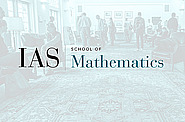Workshop on Topology: Identifying order in complex systems
Workshop on Topology: Identifying order in complex systems
Nov
07
2015
Interactive visualization of 2-D persistence modules
5:00pm|S-101
Nov
07
2015
Workshop on Topology: Identifying Order in Complex Systems
Hierarchical clustering on asymmetric networks
Facundo Mémoli
3:30pm|S-101
Nov
07
2015
Workshop on Topology: Identifying Order in Complex Systems
Topological and combinatorial methods in Theoretical Distributed Computing
Dmitry Feichtner-Kozlov
2:00pm|S-101
Nov
07
2015
Workshop on Topology: Identifying Order in Complex Systems
Topological effects in metals: from chiral and gyrotropic magnetic effects to quenched Majoranas
Joel Moore
11:30am|S-101
Nov
07
2015
Workshop on Topology: Identifying Order in Complex Systems
Critical mechanical structures: topology and entropy
Xiaoming Mao
10:00am|S-101
Apr
18
2015
Workshop on Topology: Identifying Order in Complex Systems
Sensors, sampling, and scale selection: a homological approach
Don Sheehy
5:00pm|S-101
Apr
18
2015
Workshop on Topology: Identifying Order in Complex Systems
A topological approach for investigating the intrinsic structure of neural activity
Vladimir Itskov
3:30pm|S-101
Apr
18
2015
Workshop on Topology: Identifying Order in Complex Systems
A new potential theory for the Maxwell equations
Leslie Greengard
2:00pm|S-101
Apr
18
2015
Workshop on Topology: Identifying Order in Complex Systems
Entanglement of embedded graphs
Toen Castle
11:30am|S-101
Apr
18
2015
Workshop on Topology: Identifying Order in Complex Systems
Characterizing force-chain network architecture in granular materials
Danielle Bassett
10:00am|S-101
